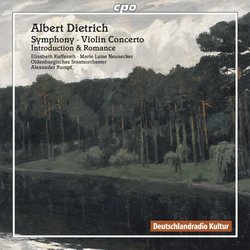| All Artists: Albert Dietrich, Alexander Rumpf, Oldenburgisches Staatsorchester Title: Albert Dietrich: Symphony; Violin Concerto Members Wishing: 0 Total Copies: 0 Label: Cpo Records Original Release Date: 1/1/2008 Re-Release Date: 11/18/2008 Genre: Classical Styles: Forms & Genres, Concertos, Symphonies Number of Discs: 2 SwapaCD Credits: 2 UPC: 761203731428 |
Search - Albert Dietrich, Alexander Rumpf, Oldenburgisches Staatsorchester :: Albert Dietrich: Symphony; Violin Concerto
 | Albert Dietrich, Alexander Rumpf, Oldenburgisches Staatsorchester Albert Dietrich: Symphony; Violin Concerto Genre: Classical |
Larger Image |
CD Details |
CD ReviewsA Proto-Brahmsian Symphony and Violin Concerto J Scott Morrison | Middlebury VT, USA | 03/16/2009 (5 out of 5 stars) "Albert Dietrich (1829-1908) is remembered today primarily as the third-man of the so-called 'three man sonata', a violin sonata to which Schumann, Brahms and Dietrich each contributed a movement. This was the 'FAE Sonata' ('Frei aber eisam' ['Free but lonely']) the three friends wrote for their fourth friend, the prominent violinist and composer, Joseph Joachim. But in his day Dietrich was a celebrated composer, conductor and teacher. And the two main works presented on this two-CD set were his most celebrated pieces: the Symphony in D Minor, Op. 20, and the Violin Concerto in D Minor, Op. 30. They received many performances for thirty or forty years after their composition and then virtually dropped out of sight. The cpo label, which has done yeoman service resurrecting forgotten works from the Romantic era, has now issued these performances by the very orchestra that Dietrich conducted for thirty years in the latter part of the 19th century, the Oldenburg State Orchestra. (Oldenburg is a city of 150,000 in lower Saxony, just west of Bremen.)
The Symphony is a 43-minute-long work of imposing construction along Brahmsian lines. The opening gestures of the first movement, for instance, recall the opening of the Brahms First Piano Concerto. The dramatic first theme is succeeded by a lyrical almost Schumannesque second theme and the two are developed with skill and inventiveness. One interesting feature is that there is a quasi-development of these themes in the midst of the exposition, and then a full sonata-allegro development in the usual place later on. Dietrich was a skillful tunesmith and most of the musical motifs in this work and the Concerto are memorable. The second movement is a pastoral idyl with a prominent part for the principal horn. The scherzo is elfin, almost Mendelssohnian. The dramatic finale makes frequent use of a timpani figure and wide-ranging wind chords; the movement has more than the usual number of themes that are memorably combined and realigned. This is a significant symphony that deserves to figure at least occasionally on the world's symphonic programs. The Violin Concerto is played by Elisabeth Kufferath, a member of the Tetzlaff Quartet as well as former concertmaster of the Bamberg Symphony. It is the second theme of the first movement that gets the lion's share of development and the movement is a bit unusual in that the soloist's cadenza is accompanied by the orchestra. The second movement, the heart of the work, is a lyrically effusive cantabile which reminds one at times of the second movement of Elgar's concerto although it precedes it by some forty years. We are jolted out of the adagio's musing mood by the finale, a vigorous workout for both soloist and orchestra cast unusually in polka rhythm. The violinist's part is a virtual moto perpetuo which Ms Kufferath conveys with sparkling passage work and double-stops. The disc concludes with the nine-minute Introduction and Romance for Horn and Orchestra, Op. 27, with the noted hornist Marie Luise Nunecker as soloist. After a slow and somewhat mysterious introduction the work moves into a cantabile section in gentle 3/4 rhythm. The Romance begins with a yearning upward major sixth and opens out into a heartfelt song-form. The conclusion is a vigorous reworking in faster tempo of materials from the slow introduction. Alexander Rumpf, a conductor I've not encountered before, leads the provincial Oldenburgisches Staatsorchester which is better than that description might imply. Although there are occasional moments of section imbalance, on the whole the orchestra acquits itself with merit and certainly we are in their and Maestro Rumpf's debt for bringing us these works by an all-but-forgotten composer. The total timing for both discs is about 86 minutes, only slightly more than the capacity of one disc, but cpo is charging full price. Some might find that a deterrent but I reiterate that these are wonderful works worth investigating. (I notice that at the AmazonUK site, the set is selling at the one-CD price.) Scott Morrison" |
